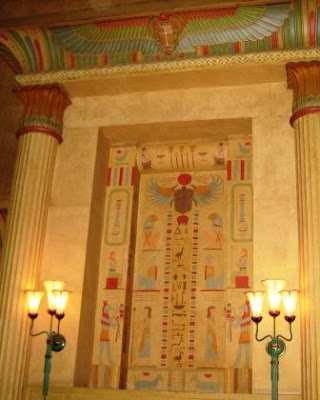
I'm enjoying my travels, but this weekend I really felt that I was whisked away on a magic carpet into a different, exotic world. Because in one day I had two experiences that let me visit a make-believe palace of wonders and mystery, and also view a forgotten ancient treasure.
I was part of a group treated to a private showing of "Tutankhamen: the Golden King and the Great Pharaohs - King Tut Exhibit," at the Atlanta Civic Center in Atlanta, Georgia. We were greeted in the foyer by the recorded voice of Harrison Ford - yes, Indiana Jones himself, narrating the story of Howard Carter's discovery of the tomb of King Tutankhamen in 1922.
Then a pair of massive wooden doors swung open, right on cue, and we entered the dark exhibit hall to mysterious music. Our handheld audio guides provided commentary alternately by Dr. Jones, or in polished English accents, as though delivered by Carter or his patron Lord Carnarvon, or by world-renowned archaeologist, Dr. Zahi Hawass. It was both informative and a little bit hokey, accompanied by choral voices just like in "Raiders of the Lost Ark." We even heard the playback of wind whistling sand storms as we stepped through a replica of the intrepid archeologist's tent.
The antiquities were stunning. First we saw stone carvings of kings, gods, and religious objects, marveling at the craftsmanship - so lifelike and yet so massive - timeless monuments of stone. The faces so smooth and placid, yet with lips and cheeks as curved and smooth you felt you could touch them and they'd be warm, like yours or mine. The torsos in stylistic poses, yet with soft bellies, the shape of nipples, the toenails. The intricate detail of the wigs and braided fibers of the ceremonial beards, the carved pleats in the statues' linen kilts.
As we progressed through the exhibit the artifacts became more human, imbued with the sense that they had been created by people just like me. Floor tiles showed painted papyrus and lotus, with water-fowl flying up from the reeds - you could see the broad brush-strokes. A shard of flagstone bore a half-finished bas-relief of a girl princess, eating a cooked fowl - it was partially carved, colored some with ochre paint, yet parts remained uncarved, roughly sketched in charcoal, erased and redrawn. It was as if the artist had just stepped away momentarily.
The exhibt drew us into each room of the tomb, as if discovering it as Carter did. The walls displayed huge murals of the photos taken at the time, showing some of the items in the cases as they had been found on that day in 1922.
Now the artifacts were more intimate, in human scale, including some of the wooden furnishings left in the tomb for the dead boy king. His wooden bed. His wooden carved chair. His mother's eye-liner.
The exhibit drew us into the rooms of the tomb, as if we were discovering it. We saw the vessels of gold and alabaster that had held the king's internal organs, preserving them separately from his mummy, in case he needed them in the afterlife. There were doll-like figurines, called shabti , to be his servants. A model boat that would magically assume the right size to sail him down the Nile on pleasure cruises. Wooden carvings of gods covered in gilt.
And jewelry; collars made of gold chains strung with carnelian and lapiz lazuli beads; hammered golden breast-plates of hawks with wings outstretched; rings with bright blue stones carved in the shape of scarab beetles.
An animated video showed how the king's preserved body was safely kept in nested coffins - three gilded wooden boxes encasing a stone sarcophagus; the stone enclosing a triple coffin of gold. Within, the mummy, beneath a face mask of gold.
Life-size photos in black and white were displayed behind the objects that Tutankhamen had worn on his body in the grave. Carved amulets of precious stone. Gold jewelry. Each one of his fingers and toes had a covering of gold, shaped and crafted like the real thing. His feet were shod in golden sandals.
Photos aren't allowed at the Tutankhamen Exhibit, so if you want to see these fabulous artifacts, you'll have to come yourself, or see it when it arrives in Dallas later this year.
But if you have a yen for Egyptian decor, there's another place in Atlanta you can find it.

A Fabulous place.
In 1922 when Howard Carter discovered the tomb of King Tut, the world was fascinated, and Egyptian styles and decor became an exotic craze.
In America as in Europe, men who aspired to business success joined together in fraternal organizations to support one another. They identified with early medieval stonemasons, gathering together in mutual aid societies, and devised rituals and traditions that enhanced the ceremonial feel of their meetings. One group of New Yorkers, inspired by some Arabian-style playacting at a meeting in Europe, called their club headquarters the Ancient Arabic Order of the Nobles of the Mystic Shrine.
The idea spread to other American cities, and as the groups grew, they needed larger and more elaborate meeting halls, which were often called Temples, enhancing the mystical and ceremonial nature of the club.
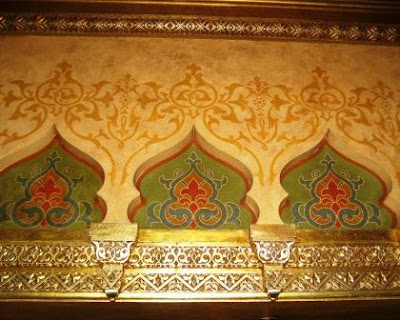
In Atlanta, the Shriners called themselves the Yaarab Temple. They bought a parcel of land on Peachtree Street, and in 1927 comissioned architects Marye, Alger and Vinour to build a temple. Naturally, the decor was to be Moorish in style, with Egyptian details inspired by the discovery of King Tut's tomb.

Unfortunately, as construction began and the economy worsened, the Shriners realized they were woefully underfunded. They made a deal with movie mogul William Fox, who was looking to establish his chain of theatres in the southeast. If he would help them complete the building, he could lease the auditorium to show movies.
The building included an auditorium intended both for movies and live shows, grand ballroom, several meeting rooms, and offices for the Shriners.
The huge auditorium, with 4678 seats, was designed to look like an Arabian courtyard, open to a night sky, twinkling with stars, a smooth plaster ceiling lit with blue lights and projectors that played images of clouds slowly moving across it. The balcony was overhung by a giant Bedouin canopy, which was actually a device to enhance the hall's acoustics. This illusion of an open sky was a popular style of theatre architecture known as "atmospheric theatres" created by an architect named John Eberson, but by the time the Fox was built, it was widely copied.
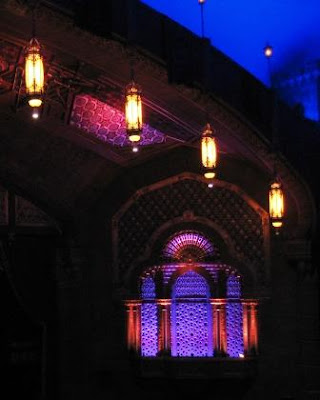
The auditorium was also furnished with a magnificent Moller pipe organ, dubbed the "Mighty Mo," which could accompany the then-silent films with a custom soundtrack.
The ballroom mimicked the temple of Rameses II at Karnak, with soaring lotus-topped pillars and scarab beetle stele.
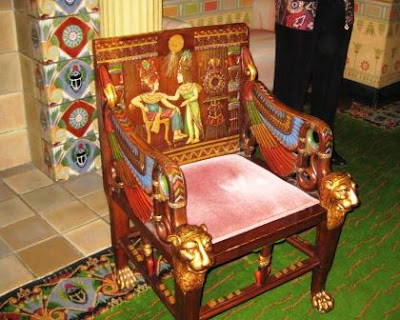
The second-floor ladies' room features chairs that were replicas of Tut's throne, and make-up tables with golden sphinxes.
The Fox Theatre opened on Christmas Day, 1929, just two months after the Stock Market crashed. Although at first the theatre's business suffered, it eventually became one of the best-loved and most popular places to go in Atlanta. It was known for its glamor and elegance. The usher corps wore snappy uniforms. Debutantes' balls were held in the Grand Ballroom. First run movies premiered in the vast auditorium.
The docent who guided our tour, a lovely lady in her sixties, remembered attending Saturday matinees as a child. She said it was a thrilling experience to sit in the dark watching "Abbot and Costello meet The Mummy,"
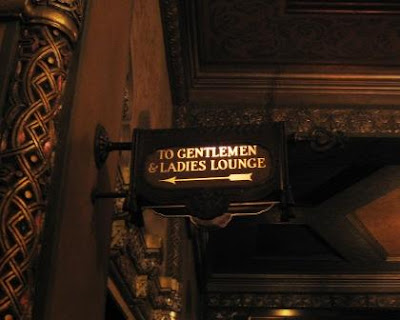
and then fearfully visit the ladies' room with its Egyptian murals and furnishings, wondering if The Mummy was lurking behind the stalls.
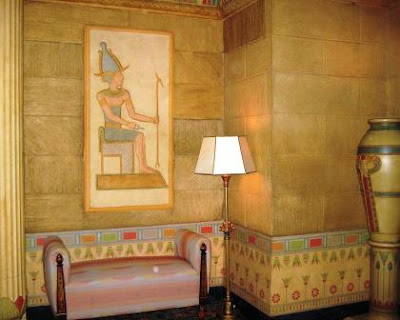 In the 1970's Southern Pacific Bell was poised to demolish the Fox Theatre to build a high-rise and parking lot, but the citizens of Atlanta undertook a successful campaign to save the theatre. Today it's one of the most successful entertainment venues in the country, presenting first-run films, Broadway shows, and concerts by a wide range of artists. If you happen to visit Atlanta, it's worth a visit.
In the 1970's Southern Pacific Bell was poised to demolish the Fox Theatre to build a high-rise and parking lot, but the citizens of Atlanta undertook a successful campaign to save the theatre. Today it's one of the most successful entertainment venues in the country, presenting first-run films, Broadway shows, and concerts by a wide range of artists. If you happen to visit Atlanta, it's worth a visit.People here call it the Fabulous Fox. Click on the link to visit their website, and see more.
3 comments:
What an amazing tour! Thanks again for sharing your incredible travels!
WOW. Fabulous post! Now I'm scheming to figure out how to get to Atlanta...
I'm filing this one away in case I ever make it to Atlanta. What a gorgeous place!
Post a Comment